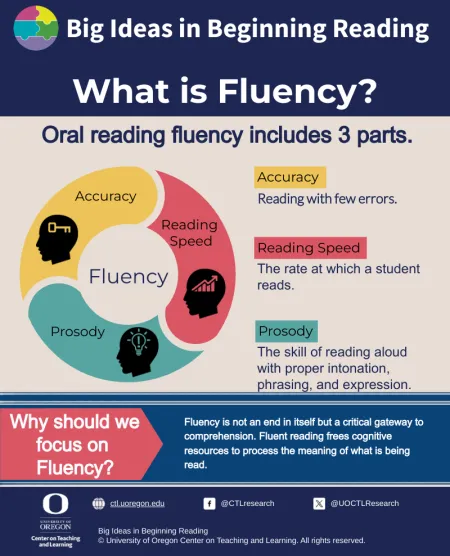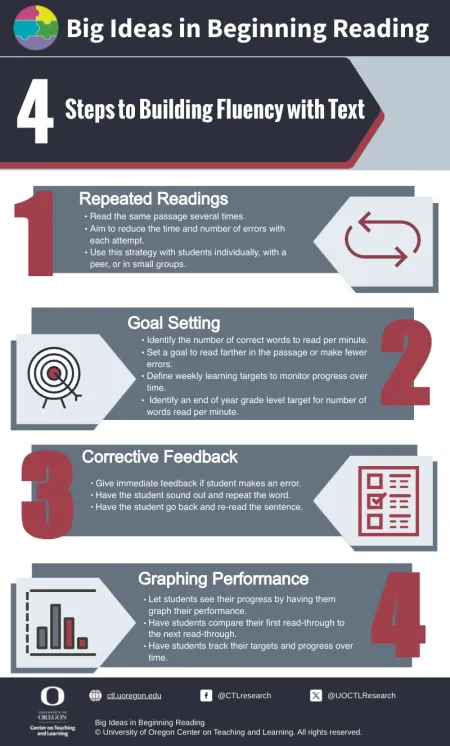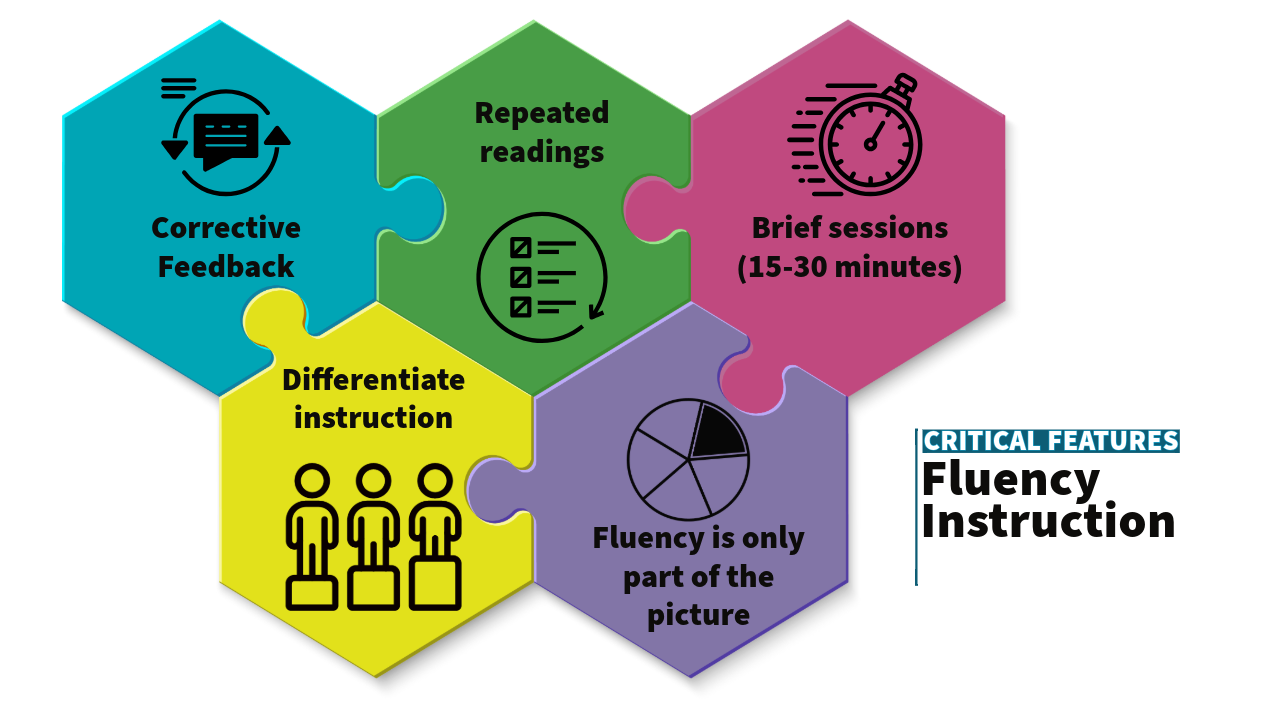The ability to read text accurately, quickly, and with proper expression. A fluent reader can read a passage smoothly without struggling to decode each word. Fluency bridges decoding and comprehension—when students read effortlessly, they can focus more on understanding the text.
Fluency is the bridge between decoding and comprehension. When students can read with accuracy, speed, and expression, they can focus their attention on making meaning from text. On this page you will learn what fluency is, why it matters, and how teachers can support it through short, structured practice. Parents and teachers can foster reading fluency in students through repeated readings, goal setting, constructive feedback, and progress tracking.
Overview
Mini Mastery - Fluency
What do we mean when we talk about fluency?
Fluency with text is the ability to read text accurately, quickly, and with proper expression. A fluent reader can read a passage smoothly without struggling to decode each word, and has fundamental skills that are so "automatic" that reading doesn’t require conscious attention. So, what does that mean exactly? Let’s review some examples. People can perform many tasks with automaticity, or automatically, like walking, riding a bike, or driving a car. Fluency, like riding a bike, develops through practice. Students go from sounding out individual letters and letter combinations, to reading words quickly and effortlessly, with lots of opportunities for practice until reading the words can be performed with a high rate of success.
Fluency in oral reading has 3 parts:
- Accuracy - which is reading with few errors.
- Reading - speed or the rate at which a student reads.
- Prosody - the skill of reading aloud with proper intonation, phrasing, and expression.
To be a fluent reader, all three of these components must be in place.
What do fluent readers look like?
Fluency research says that successful readers…
- rely primarily on the letters in the word rather than context or pictures to identify familiar and unfamiliar words.
- process virtually every letter.
- use letter-sound correspondences to identify words.
- have a reliable strategy for decoding words.
- read words a sufficient number of times for words to become automatic.
Why should we focus on fluency?
To gain meaning from text, students must read fluently. Proficient readers are so automatic with each component skill (phonological awareness, decoding, vocabulary) that they focus their attention on constructing meaning from the print. These component skills need to be well developed to support understanding. It is not enough to be simply accurate; the skill must be automatic. So, fluency is not an end in itself, but is the bridge to comprehension. Fluent reading frees up cognitive resources to better process the meaning of the words.
Now that we know why it’s necessary, how do we help build fluency?
- Effective fluency instruction should include repeated readings, or practice, with passages that the student can read with a high level of accuracy.
- Instruction should be brief, about 15 to 30 minutes.
- Instruction should include corrective feedback.
- Students should be instructed to set goals and graph progress.
- Teachers should keep in mind that fluency is only part of the bigger picture.

Download Infographic
4 Steps to Building Fluency with Text
1. Repeated Readings
- Read the same passage several times.
- Aim to reduce the time and number of errors with each attempt.
- Use this strategy with students individually, with a peer, or in small groups.
2. Goal Setting
- Identify the number of correct words to read per minute.
- Set a goal to read farther in the passage or make fewer errors.
- Define weekly learning targets to monitor progress over time.
- Identify an end of year grade level target for number of words read per minute.
3. Corrective Feedback
- Give immediate feedback if the student makes an error.
- Have the student sound out and repeat the word.
- Have the student go back and re-read the sentence.
4. Graphing Performance
- Let students see their progress by having them graph their performance.
- Have students compare their first read-through to the next read-through.
- Have students track their targets and progress over time.

Download Infographic
Role in Reading
The role of fluency is to support comprehension by making decoding automatic. Fluency is built on three key components: accuracy (reading with few errors), rate (reading with appropriate speed), and prosody (reading with expression). When students are fluent readers, they can devote their cognitive energy to understanding what they read, rather than decoding every word.
Effective fluency instruction is taught and developed across multiple grade levels, uses repeated readings, brief practice sessions, corrective feedback, and differentiated support to build accurate, expressive, and automatic reading.
Critical Features of Fluency Instruction

Effective fluency instruction helps students move from slow, effortful reading to reading that is accurate, expressive, and automatic. The following features support this growth:
- Corrective Feedback: When students make errors, immediate feedback helps them correct mistakes and strengthen word recognition.
- Repeated Readings: Give students multiple chances to read the same passage, aiming for smoother, faster, and more accurate reading each time.
- Brief Sessions (15–30 minutes): Fluency practice should be focused and time-bound, fitting into the daily routine without overwhelming instruction.
- Differentiate Instruction: Tailor fluency activities to each student’s reading level and progress to ensure targeted, meaningful practice.
- Fluency Is Only Part of the Picture: While important, fluency is one of several foundational skills. Instruction should always connect back to overall reading comprehension and student needs.
These features work together to build confident, fluent readers who can focus on meaning while they read.
Assessment in Action
Oral Reading Fluency Scoring
Watch this video to see a demonstration of how to score oral reading fluency using a passage and stopwatch. For more information, see the DIBELS Research Site
.
The Science of Reading
The Science of Reading identifies fluency as a key component of skilled reading. Fluent readers decode words automatically, allowing them to focus on comprehension. Research supports fluency instruction that includes repeated reading, goal setting, and progress monitoring to build accuracy, rate, and expression.
Key Citations and Research
- Harn, B., & Chard, D. (2008). Teaching tutorial 6: Repeated readings to promote fluency. Council for Exceptional Children (CEC), Division for Learning Disabilities (DLD).
- Hasbrouck, J. (1998). Reading fluency: Principles for instruction and progress monitoring. Professional development guide. Texas Center for Reading and Language Arts.
- Hasbrouck, J., & Glaser, D.R. (2012). Reading fluency: Understanding and teaching this complex skill (Training Manual). Gibson Hasbrouck & Associates.
- Kuhn, M.R. & Stahl, S.A. (2000). CIERA Report #2-008. Fluency: A review of developmental and remedial practices. US Department of Education. National Reading Panel.
- National Reading Panel (US), National Institute of Child Health, & Human Development (US). (2000). Teaching children to read: An evidence-based assessment of the scientific research literature on reading and its implications for reading instruction: Reports of the subgroups. National Institute of Child Health and Human Development, National Institutes of Health.
- University of Oregon. (2013). Enhanced core reading instruction. Center on Teaching and Learning. U.S. Department of Education (2016).
- Foorman, B., Beyler, N., Borradaile, K., Coyne, M., Denton, C. A., Dimino, J., Furgeson, J., Hayes, L., Henke, J., Justice, L., Keating, B., Lewis, W., Sattar, S., Streke, A., Wagner, R., & Wissel, S. (2016). Foundational skills to support reading for understanding in kindergarten through 3rd grade (NCEE 2016-4008). Washington, DC: National Center for Education Evaluation and Regional Assistance (NCEE), Institute of Education Sciences, U.S. Department of Education. Retrieved from the NCEE website: http://whatworks.ed.gov.

